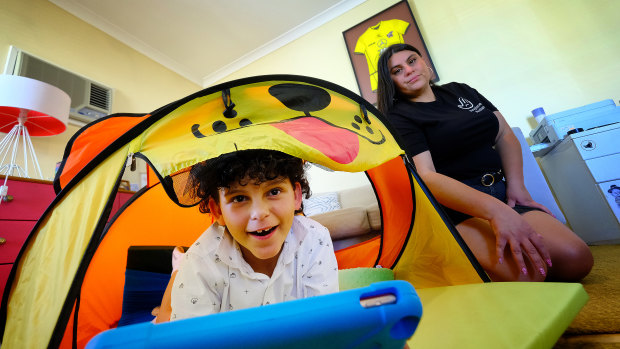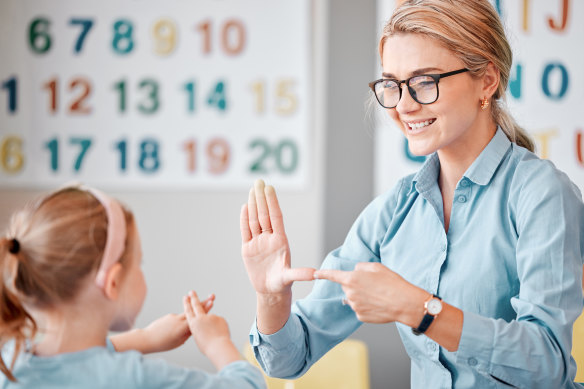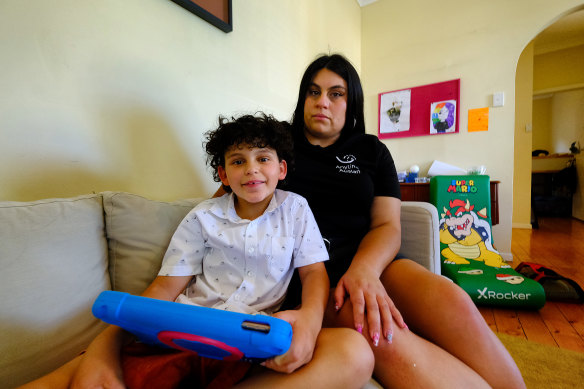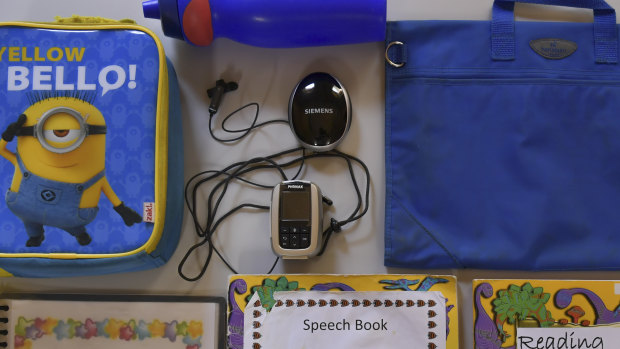‘100 per cent failing deaf students’: Why this mother needed to move cities for her deaf child
The Victorian education system is leaving behind many deaf and hard-of-hearing children, warn experts and advocates, who are calling for more resources and awareness of these students’ needs.
A lack of staff, adequate support and resources in regional and rural areas means some deaf or hard-of-hearing students aren’t receiving enough support to ensure they get a good education.
Raquel Pantelic moved from Colac to Melbourne so that her son, Zveki, who is deaf, would get the best support for his education.Credit:Luis Enrique Ascui
Dr Kaye Scott, who has worked in the deaf and hard-of-hearing sector for more than 30 years, said there were patches of excellence in deaf education, but most teachers would agree some students were being let down.
Scott said there was still a lot of inequity across the state. She said location often determined whether students received the support they “desperately need to develop skills commensurate with their peers”.
There were 98,000 Australian children aged up to 17 who were deaf or hard of hearing in 2017-18, according to the Australian Bureau of Statistics.
Victoria has three government schools for the deaf and 16 state schools with deaf facilities. Those with hearing difficulties who can’t attend those schools have the option of attending a mainstream school, where a specialist teacher will visit to provide specific support for their needs. However, in regional and rural schools, those visits might only happen fortnightly.
A lack of Auslan interpreters or teachers of the deaf, especially in rural and regional areas, creates a gap in accessibility.Credit:iStock
In 2021, Deaf Australia surveyed 500 parents and carers of children who were deaf or hard of hearing. Three quarters of them said teachers needed to better understand their child’s communication needs.
Raquel Pantelic, who is hard of hearing and has a seven-year-old child, Zveki, who is deaf, said Victoria was “100 per cent failing deaf students”.
Originally from Colac, Pantelic moved to Melbourne when Zveki was one because her home town lacked childcare centres and schools that catered properly for deaf education. Zveki is now seven and uses Auslan.
“There’s a real lack of knowledge around deaf needs and what needs to be in place for a child to thrive,” she said.
Raquel Pantelic and her son, Zveki, who is deaf.Credit:Luis Enrique Ascui
Australian Federation of Disability Organisations chief executive Ross Joyce said there needs to be a complete rethink of how education is provided to those with specific support needs.
“Young people with disability are not encouraged to pursue tertiary education and are pushed out to work at the end of secondary school or into sheltered workshops or onto unemployment. We must do better,” he said.
Deaf Victoria general manager Philip Waters said: “Can you imagine, as a 10-year-old who cannot communicate in a variety of scenarios, having to wait two weeks at school for a teacher who can understand them? It is too little and does not make much difference.”
Waters said 97 per cent of deaf and hard-of-hearing babies were born to parents who did not have hearing issues, and 80 per cent of them did not know Auslan, which is proven to help deaf children with literacy.
A roger device can be used to help deaf students communicate at school.Credit:Eddie Jim
According to the 2021 census, 16,242 Australians use Auslan at home, but Deaf Australia believes that figure underestimates the true number.
“The [education] department does not recognise that deaf students lie on the dual intersections of belonging to both a cultural and linguistic group as well as a type of disability,” Waters said.
Skye Kakoschke-Moore, chief executive of Children and Young People with Disability Australia, said there was a lack of data on funding given to deaf students in regional and remote areas and how it was used.
A lack of Auslan interpreters or teachers of the deaf, especially in rural and regional areas, also creates a gap in accessibility.
According to Deaf Australia’s submission to the Royal Commission into Violence, Abuse, Neglect and Exploitation of People with Disability, there were only about 10 to 15 Auslan interpreting students a year in Victoria. Of those, up to five would pass the certification test.
“This means that the interpreting industry remains stagnant with only approximately seven to 10 new interpreters nationally each year,” the report noted.
Bianca Oldham, whose 16-year-old son is deaf, said qualified Auslan interpreters often chose highly paid freelance work rather than teaching, a role that wouldn’t pay as much.
“The teachers of the deaf are asking my children what the sign for things is. It shouldn’t be that way. They should be fluent,” she said.
A three-year research project has been launched to connect services, collect national data, find funding gaps and assess outcomes for deaf and hard-of-hearing children.
Valerie Sung, associate professor at Murdoch Children’s Research Institute, launched a national registry for child-hearing-health outcomes last month, which will focus on students in Victoria and Queensland first.
“Everybody who works with these children has recognised there are inequities in outcomes; that’s why there is so much work that needs to be done in this area.”
An Education Department spokesperson said the government was spending $1.6 billion on disability inclusion reforms in public schools to increase support for students. The funding is part of a $3 billion investment in inclusive education for students with disabilities.
The Morning Edition newsletter is our guide to the day’s most important and interesting stories, analysis and insights. Sign up here.
Most Viewed in National
From our partners
Source: Read Full Article



